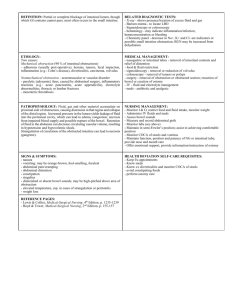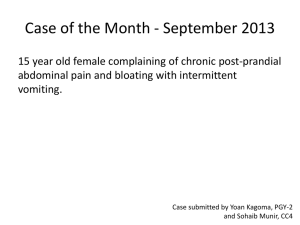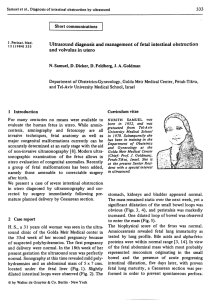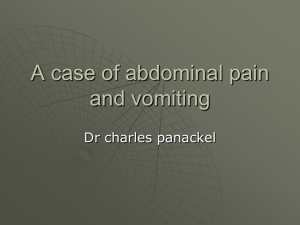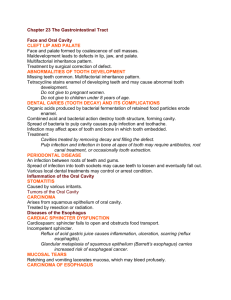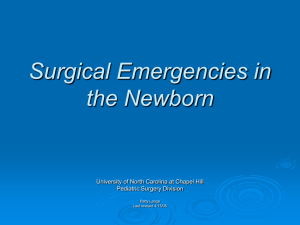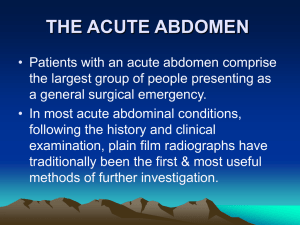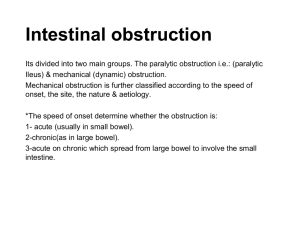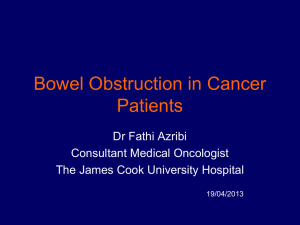Pediatric Surgery :
advertisement
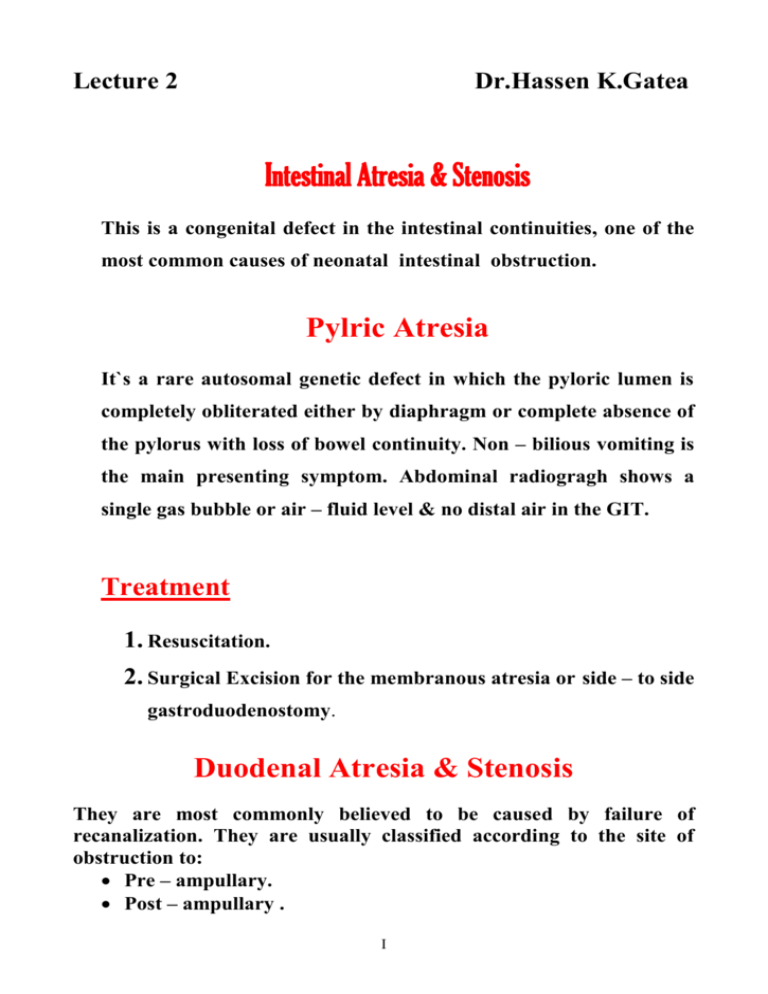
Lecture 2 Dr.Hassen K.Gatea Intestinal Atresia & Stenosis This is a congenital defect in the intestinal continuities, one of the most common causes of neonatal intestinal obstruction. Pylric Atresia It`s a rare autosomal genetic defect in which the pyloric lumen is completely obliterated either by diaphragm or complete absence of the pylorus with loss of bowel continuity. Non – bilious vomiting is the main presenting symptom. Abdominal radiogragh shows a single gas bubble or air – fluid level & no distal air in the GIT. Treatment 1. Resuscitation. 2. Surgical Excision for the membranous atresia or side – to side gastroduodenostomy. Duodenal Atresia & Stenosis They are most commonly believed to be caused by failure of recanalization. They are usually classified according to the site of obstruction to: Pre – ampullary. Post – ampullary . I Peri – ampullary (the majority). Associated anomalies: 40% have trisomy 21 (Down`s syndrome), cardiac, genitourinary, anorectal & esophageal atresia. Diagnosis: [A] Antenatal U/S shows polyhydrammios, dilated stomach & proximal Duodenum [B] Vomiting; clear or bile stained, usually starts within hours of birth dehydration follow rapidly. [C] because of high level of atresia there is little or no abdominal distension. [D] Diagnosis of incomplete intestinal obstruction may be delayed beyond neonatal period. [E] X-ray of the abdomen in upright position is all that is necessary to confirm the diagnosis. A large collection of air in the distended stomach & first portion of the duodenum leading to double bubble appearance. Treatment Resuscitation ( it`s not an emergency case) II Surgery: diamond – shaped or side – to side duodenoduodenostomy . Jejunoileal Atresia & Stenosis Etiology The most favored theory is the localized intrauterine vascular accident with ischemic necrosis of the sterile bowel The obstruction is caused by membrance or web formed by mucosa & submucosa. The dilated Type I proximal & distal collapsed bowels are in continuity without mesenteric defect. III The proximal bowel connects to the collapsed distal bowel by short fibrous cord, the mesentry is intact Type II in both type I & II & the total length of small bowel is normal Proximal & distal bowels are disconnected ( the fibrous band is absent ) & V – shaped mesenteric defect of varying size is present. Type III (a ) The total length of bowel is subnormal. IV (Apple – peel or Christmas tree) consist of proximal jejunal atresia near the ligament of Type III (b ) Tretiz , absence of SMA* beyond the origin of celiac branch . Large mesenteric defect with significant loss in intestinal length is present *Superior Mesenteric A There`s multiple segment atresia combination of types I & III. Grossly shortened bowel length & Type IV high mortality. Clinical Manifestations: [1]Polyhydramnios during pregnancy. [2] Bilious vomiting on the 1st day of life. [3] Dehydration. [4] Fever. [5] Unconjugated hyperbilirubinemia. V [6] Abdominal distension. [7] 60-70% of these neonates fail to pass meconium on the 1st day of life . [8] Although meconium may appear normal it is more common to find: Grey Plugs of mucus passed via the rectum. [9] Signs of ischemia & peritonitis (tenderness, rigidity, edema and erythema of abdominsal wall) Diagnosis [1] Clinical findings. [2] Plain X – ray of abdomen that shows few gases – filled & fluid filled loops of small bowel, but the remainder of the abdomen is gasless. Air – fluid level may be scanty or absent & may become evident only after decompression via NG tube. Management 1) Resuscitation (I.V. fluids, NGtube, ABS). 2) Surgery depends on pathological findings. Resection of proximal dilated or hypertrophied bowel with primary end – to end anastomosis with or without tapering of the proximal bowel is the most common surgery. VI Malrotation The term malrotation refer to a condition in which the midgut remain unfixed and suspended on a narrow-based mesentery. Embryology . Three stages of development of the midgut are recognized. Stage I The first stage occurs during the fourth to 10th weeks of gestation. The midgut is forced out into the physiologic hernia within the umbilical cord. Stage II Stage II occurs at the 10th to 12th weeks of gestation, during which the midgut migrates back into the abdomen. Stage III During the 12th week of gestation various parts of the mesentery and the posterior parietal peritoneum fuse, notably in the right paracolic gutter. Consequences of errors of normal rotation Errors may occur at any one of the three stages, with varying consequences. Stage I VII Failure of the intestine to return into the abdomen results in the formation of an exomphalos/omphalocele. Stage II During this stage a number of errors could occur: 1. Non-rotation – rotation may fail to occur following re-entry of the midgut into the abdomen. 2. Incomplete rotation – counterclockwise rotation is arrested at 180◦. The cecum lies in a subhepatic position in the right hypochondrium. The duodeno- jejunal rotation is similarly arrested and the duode- nojejunal flexure lies to the right of the midline. 3. Reversed rotation – the final 180◦ rotation occurs in a clockwise direction, with the colon coming to lie posterior to the duodenum and superior mesenteric vessels. 4. Hyperrotation – rotation continues through 360◦ or more so that the cecum comes to rest in the region of the splenic flexure in the left hypochondrium. 5. Encapsulated small intestine – the avascular sac which forms the lining of the extraembryonic celom returns en masse into the abdomen with the intestine. The most common error is incomplete rotation. Stage III VIII Rotation occurs normally but fixation defective, resulting in a "mobile cecum". Associated abnormalities Developmental abnormalities of mid gut rotation and fixation are predictable when the intestine is malpositioned at parturition(e.g.,omphalocele,gastroschiasis,and congenital diaphragmatic hernia ) Other important associations are intestinal atresia ,imperforated anus ,cardiac anomalies, downs syndrome. Incidence Malrotation may go undetected throughout the life . 50-75%of patients with malrotation who become symptomatic do so in first month of life ,and approximately 90%of clinical symptoms occur in children younger than 1 year of age. Clinical presentation Neonatal period -acute strangulating obstruction acute life –threatening strangulating intestinal obstruction occurs as a result of midgut volvulus .the infant presented in a shocked and collapsed state with bilious vomiting ,abdominal tenderness with or with out distension ,and the passage of dark blood rectally .edema and erythema of the anterior abdominal wall develop as the volvulus become complicated by intestinal gangrene ,perforation and peritonitis. IX -sub acute intestinal obstruction . Recurrent episodes of sub acute intestinal obstruction are usually a forewarning of volvulus. the only sign may be bile stained vomiting . Infant and children Duodenal obstruction is most commonly the result of extrinsic compression from Ladd’s peritoneal bands. -The most common symptom is intermittent vomiting which is occasionally bile stained. -failure to thrive or malnutrition. -older children may presented with feature of anorexia nervosa(early satiety or pain associated with intake of food result in reluctance to eat or food aversion). Diagnosis -clinical manifestation -plain abdominal radiography Classical early plain abdominal radiographic findings of malrotation with volvulus are those of a distended stomach and proximal duodenum with a paucity of air in the distal small bowel. In infant presenting in shock with features of acute strangulating obstruction ,no need for further investigations. -upper GI contrast study Typically malrotation with volvulus produces an incomplete obstruction of the descending or distal duodenum with appearance of X extrinsic compression and torsion, variably described as a birds beak, corkscrew or coiled appearance. The duodenojejunal junction is not normally located (the usual position is to left of the midline ,rising to approximately the level of the pylorus and fixed well posterior. Rather , it is anterior, low , and often in midline or to the right of the midline. The small bowel is to the right of midline ,and the colon and cecum are to the left. Treatment Neonates and infants with rotational abnormalities require operative management due to risk of volvulus which lead to strangulation. Patients presenting with acute strangulating obstruction require rapid resuscitation before proceeding to surgery this comprise-Rapid IV volume replacement (plasma 20ml /kg body weight) - NG decompression -correction of electrolyte &acid –base balance. -broad spectrum AB. -correction of hypothermia. Then after resuscitation proceeding to surgery: -laparotomy is performed via upper abdominal transverse incision in infant &midline in children. -relieve the volvulus by counterclockwise rotation. -in patients with intestinal gangrene resection with end to end anastomosis . - Ladd’s band (folds of peritoneum extending from the cecum and ascending colon across the duodenum to the right paracolic gutter and XI to liver and gallbladder) carefully divided, this operation called Ladd’s operation. XII
